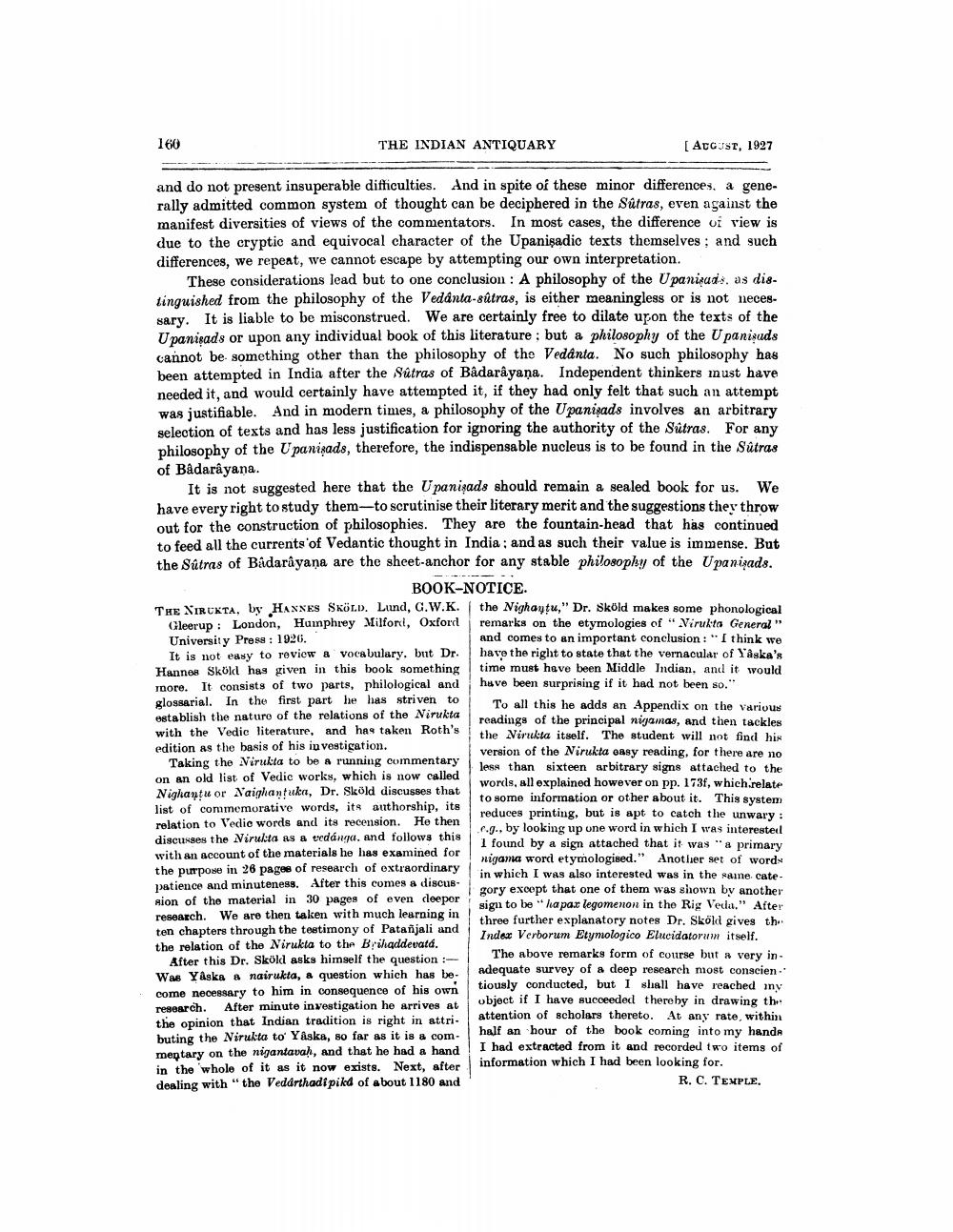________________
160
THE INDIAN ANTIQUARY
[ ACCUST, 1927
and do not present insuperable difficulties. And in spite of these minor differences, a generally admitted common system of thought can be deciphered in the Sútras, even against the manifest diversities of views of the commentators. In most cases, the difference of view is due to the cryptic and equivocal character of the Upanişadic texts themselves; and such differences, we repeat, we cannot escape by attempting our own interpretation.
These considerations lead but to one conclusion : A philosophy of the Upanigads, as distinguished from the philosophy of the Vedanta-sútras, is either meaningless or is not necessary. It is liable to be misconstrued. We are certainly free to dilate upon the texts of the Upanigads or upon any individual book of this literature : but a philosophy of the Upanisuds cannot be something other than the philosophy of the Vedanta. No such philosophy has been attempted in India after the Sútras of Bådarayaņa. Independent thinkers inust have needed it, and would certainly have attempted it, if they had only felt that such an attempt was justifiable. And in modern times, a philosophy of the Upanipads involves an arbitrary selection of texts and has less justification for ignoring the authority of the Sutras. For any philosophy of the Upanişads, therefore, the indispensable nucleus is to be found in the Satras of Bådarayana.
It is not suggested here that the Upanigads should remain a sealed book for us. We have every right to study them-to scrutinise their literary merit and the suggestions they throw out for the construction of philosophies. They are the fountain-head that has continued to feed all the currents of Vedantic thought in India, and as such their value is immense. But the Satras of Badarayana are the sheet-anchor for any stable philosophy of the Upanišads.
BOOK-NOTICE. The XIRUKTA. by HANNES SKÖLD). Lund, G.W.K. the Nighaytu," Dr. Sköld makes some phonological
Gleerup : London, Humphrey Milforci, Oxford remarks on the etymologies of "Mirukto General" University Press : 1926.
and comes to an important conclusion: "I think we It is not easy to review a vocabulary. but Dr. have the right to state that the vernacular of Yagka's Hannes Skold has given in this book something time must have been Middle Indian, and it would moore. It consists of two parts, philological and have been surprising if it had not been so." glossarial. In the first part he has striven to
To all this he adds an Appendix on the various establish the nature of the relations of the Nirukta
readings of the principal nijamas, and then tackles with the Vedic literature, and has taken Roth's
the Nirkta itself. The student will not find his edition as the basis of his investigation.
version of the Nirukta easy reading, for there are no Taking the Nirukta to be a running commentary
less than sixteen arbitrary signs attached to the on an old list of Vedic works, which is now called
words, all explained however on pp. 173f, which relate Nighantu or Naighantuka, Dr. Sköld discusses that
to some information or other about it. This system list of commemorative words, its authorship, its
reduces printing, but is apt to catch the unwary: relation to Vedic words and its recension. He then
..9.. by looking up one word in which I was interested discusses the Nirulta as a tedáng, and follows this
I found by a sign attached that it was "a primary with an account of the materials he has examined for
nigama word etymologised." Another set of words the purpose in 26 pages of research of extraordinary
in which I was also interested was in the rame catepatience and minuteness. After this comes a discus
gory except that one of them was shown by another sion of the material in 30 pages of even cleeper
sign to be hapat legomenon in the Rig Veda." After research. We are then taken with much learning in
three further explanatory notes Dr. Sköll gives the ten chapters through the testimony of Patanjali and
Inder Verborum Etymologico Elucidatorum itself. the relation of the Nirukta to the Brihaddevata. After this Dr. Sköld asks himself the question :
The above remarks form of course but very inWas Yaska s nairukta, a question which has be.
Adequate survey of a deep research most conscien.' come necessary to him in consequence of his own
tiously conducted, but I shall have reached iny research. After minute investigation he arrives at
object if I have succeeded thereby in drawing the the opinion that Indian tradition is right in attri
attention of scholars thereto. At any rate, within buting the Nirukta to Yaska, so far as it is a com
half an hour of the book coming into my hande mentary on the nigantavah, and that he had a hand! I had extracted from it and recorded two items of in the whole of it as it now exists. Next, after information which I had been looking for. dealing with "the Vedúrthadi pikd of about 1180 and
R. C. TEMPLE.




